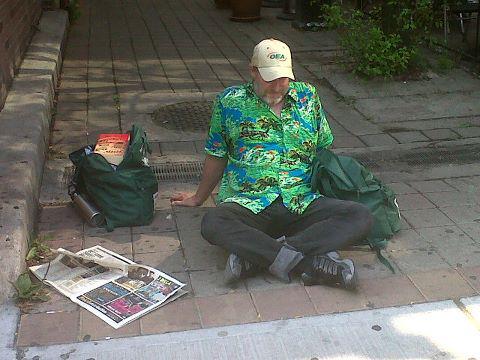This story is Part 4 of a seven-part series, U of T Engineering in the City, running throughout fall 2015.
Two years ago, U of T Engineering professor Mark Fox (MIE) spent 36 hours living on the street. He did it partly as a charity fundraiser, but mostly to get a better sense of how the homeless live and how social services are delivered. “It led me to ask the question: what are we doing as engineers to address the needs of people less fortunate than ourselves?” he says.
As a result of his experience, Fox co-founded the Centre for Social Services Engineering (CSSE) at U of T. Now more than a year old, the Centre applies industrial and systems engineering techniques — including mathematical analysis, big data and machine learning — to improve the delivery of goods and services to vulnerable populations in urban centres.
Fox, who was named U of T Distinguished Professor of Urban Systems Engineering earlier this year, has spent decades proposing how to make organizations more efficient. In his field of industrial engineering, innovations like supply chain management and just-in-time delivery are routinely used to help companies lower their costs and improve performance.
The same techniques that are used to analyze what goes on within a manufacturing corporation can be just as easily applied to other sectors. In the last 30 years, banks, hospitals and other organizations have increasingly hired industrial engineers to redesign their operations and make them more efficient and effective. According to Fox, there’s no reason why social services shouldn’t benefit as well.
How exactly does an engineer help meet social needs? Fox provides an example: “Imagine that you’re a recent immigrant to Toronto, and that you’re pregnant,” he says. In this scenario, as a new mother you’ll need a crib, but you have very little money and no social network to rely on. Meanwhile, a grandmother living in a more affluent neighbourhood has bought a crib for her grandchildren for when they visited, but they have outgrown it.
“The crib has been sitting in the basement for the last three years or so, and she doesn’t even remember it’s there,” explains Fox. The crib is sitting unused and the grandmother doesn’t know there is a need in her community. Furthermore, because she’s forgotten it, she hasn’t even thought to post it on an online classified site or donate it.
Fox’s idea is to use the same tools that marketers use to build profiles of their target audiences — analyzing purchases from anonymized credit card data or looking at household surveys — to build up a picture of what resources are available and where. The goal, he says, is “to be able to learn what the supply side has, and then figure out a way in which we can reach out. Such a system would identify people who have goods and services that people need but are unaware of.”
Fox also notes that in Ontario alone, there are 45,000 charities or non-governmental organizations that provide a wealth of services. ”Some may be furniture banks, some may provide transportation, some may just provide money,” he says. He envisions a kind of virtual NGO that would integrate all of these services and make them available through a single portal. Fox also hopes to integrate the social needs marketplace into existing programs like 211 Toronto, a hotline that helps Torontonians find social services.
Another CSSE project focuses on the representation and analysis of city indicators. It builds on the recently developed ISO 37120 standard of 100 indicators to measure city performance, led by Professor Patricia McCarney at U of T’s Global Cities Institute. The CSSE’s PolisGnosis project, named after the Greek words for “city” and “knowledge”, seeks to create a consistent and meaningful way of representing these indicators on the Semantic Web, and automate the diagnosis of a city’s performance.
As an example, Fox refers to the ratio of students to teachers, one of the ISO indicators. Many cities don’t yet provide the data from which their indicator was derived, and those that do could be using data inconsistent with the indicator’s definition. For example, they may count school board administrators as teachers, or use different dividing lines between primary and secondary school. By enabling consistent, meaningful analysis of such metrics, the PolisGnosis project aims to help lower-performing cities to make improvements by diagnosing the root cause of their under performance.
Fox believes there are lots of ways that engineering analysis can help make life better for those in need. While the CSSE is not the first attempt to use organizational management techniques to address these problems, Fox says it is the first time that it’s been raised to such a level within an engineering faculty.
“It’s not a question of why is it opportune now,” he says. “It could have been done 30 years ago. It’s really a question of why did it take so long.”
Learn more about the Centre for Social Services Engineering.




